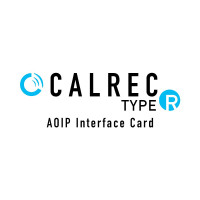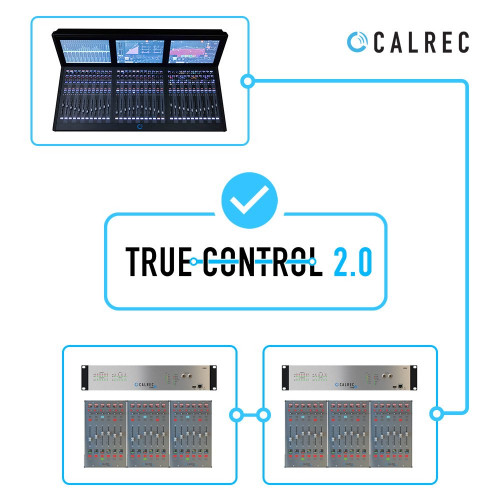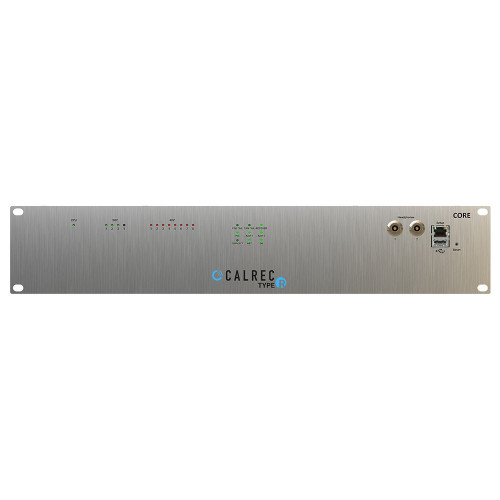Calrec Type R - AoIP Interface Card (US6493)
Calrec Type R - AoIP Interface Card
(US6493)
- Optional / additional AoIP card for Calrec Type-R Core modules and I/O Boxes
For more information on Calrec Type R,
call us on 01727 821 870
Description
Calrec Type R - AoIP Interface Card
Type R I/O boxes have two A/B pairs of 1Gbps AoIP connections. Type R Cores can be supplied without any AoIP Interfaces fitted, in which case although the two pairs of AoIP connectors are fitted, these will not be functional.
Optionally one or two AoIP Interfaces may be fitted, the second card doubling the Core audio capacity.
In addition to providing switch ports for each devices’ Audio over IP connections, at least one switch port needs to be available on each AoIP network as a whole for a Connect server to communicate with devices on that network.
Typically, Connect will be served by a Type R core via the Core Surface connections. It should interface with both A and B networks in order to provide redundant communications with all devices. A backup Connect server should also be considered, though having an active Connect server will not be an on-air critical requirement for many users who will have a fairly static network configuration.
Type R cores can be configured to act as Connect servers, but only one server is needed per network.
At least one spare additional AoIP network switch port should normally also be available on each network for System Administration, to allow engineers access to network and 3rd party device configuration and diagnostics. This same connection can also be used to access Connect’s UI for audio stream and device management. Alternatively, Connect’s UI can be accessed via a separate network (if served by a Type R core, the UI can also be accessed via its rear panel LAN ports).
In some cases, one or more AoIP network switch ports will be required for interfacing with 3rd party clock masters, though these are likely to be larger systems with other 3rd party devices on the same network, and therefore usually where customers are managing their own switch and network requirements.
On a basic Type R system, a given Type R core will lock to a Wordclock reference (or could even free run), and that core will be the clock master for all other AoIP devices on the network (including any other cores), passing sync along with audio via one of its AoIP ports (so additional switch ports for sync are not needed in these cases).
It is possible to connect a small system using only a single pair of switches (Example 4).
If only a single point of access is required for System Administration, or a backup Connect server is not required, then these ports can be freed up for I/O connections.
Likewise, if there is only one core, or the core/s do not have a second AoIP module, then those ports can also be freed up for I/O. If ports 9/10 are not needed to connect with other switches, then those ports can also be used for I/O (or anything else), or they can be left free for future expansion.
Bandwidth, Inter-Switch Links and Larger Networks
Network topology and bandwidth management are impacted not just by the quantity, but also by the physical location of devices. Each copper Ethernet cable should be less than 100m total length (factoring in cable routing and looming, so often 90m is quoted). Fibre SFP ports or additional switch hops need to be used to extend the range beyond 100m.
Where switches are connected together, one should be mindful of the bandwidth available on the inter-switch links. Multiple links can be fitted between switches as trunks to increase bandwidth (switches need to be appropriately configured to support such connections using LACP link aggregation), and many switches have a pair or more of SFP slots that are capable of higher bandwidth, intended to be used to connect to other switches.
On the 10 (8+2) port Quarra switches that Calrec currently use, 2 of the ports are SFP slots that can be fitted with either 1Gbps or 2.5Gbps SFP modules. Note that switches are not supplied with the SFP modules.
As a general rule of thumb for AoIP, audio traffic should not exceed roughly 50% of the capacity on a link. This broadly equates to 256 channels of audio over a 1Gbps link. This is a somewhat conservative guideline, but it is a safe recommendation for critical live audio application such as broadcast.
Audio is not the only data being passed, even on a dedicated audio network there is still additional traffic. Higher channel counts can be achieved, but deterministic network conditions are required to successfully exceed the safe working recommendations.
Type R Cores can pass up to 256 audio channels over each AoIP Interface card. Using 32 x 8 channel streams (at 32 bit / 48k / 125us packet time), the bandwidth consumption of audio for each port would be 554Mbps. With 2 cards fitted, the overall audio consumption of a Type R core can potentially be more than 1Gbps.
If large amounts of audio/data have to pass over a given network segment such as an inter-switch link, then higher bandwidth SFPs should be used for those segments (or multiple aggregated links).
Type R I/O boxes have a single redundant pair of AoIP ports, capable of passing up to 64 channels of audio. As the largest Type R I/O boxes only have 16 channels of physical audio I/O ports, typical actual usage would be only 35Mbps. If required, audio bandwidth can be reduced by using a 1ms packet time (at the cost of increased latency), or by using 24 bit audio (sacrificing the additional headroom we provide for our mic inputs).
For larger networks with lots of switches, instead of daisy-chaining them together, they should connect via an additional switch, in order to limit the number of switches that data has to pass through to get from point A to point B, providing more uniform latency, and making bandwidth simpler to manage.
Video
Introducing the Calrec Type R
Customer Reviews
This item currently has no reviews.


























